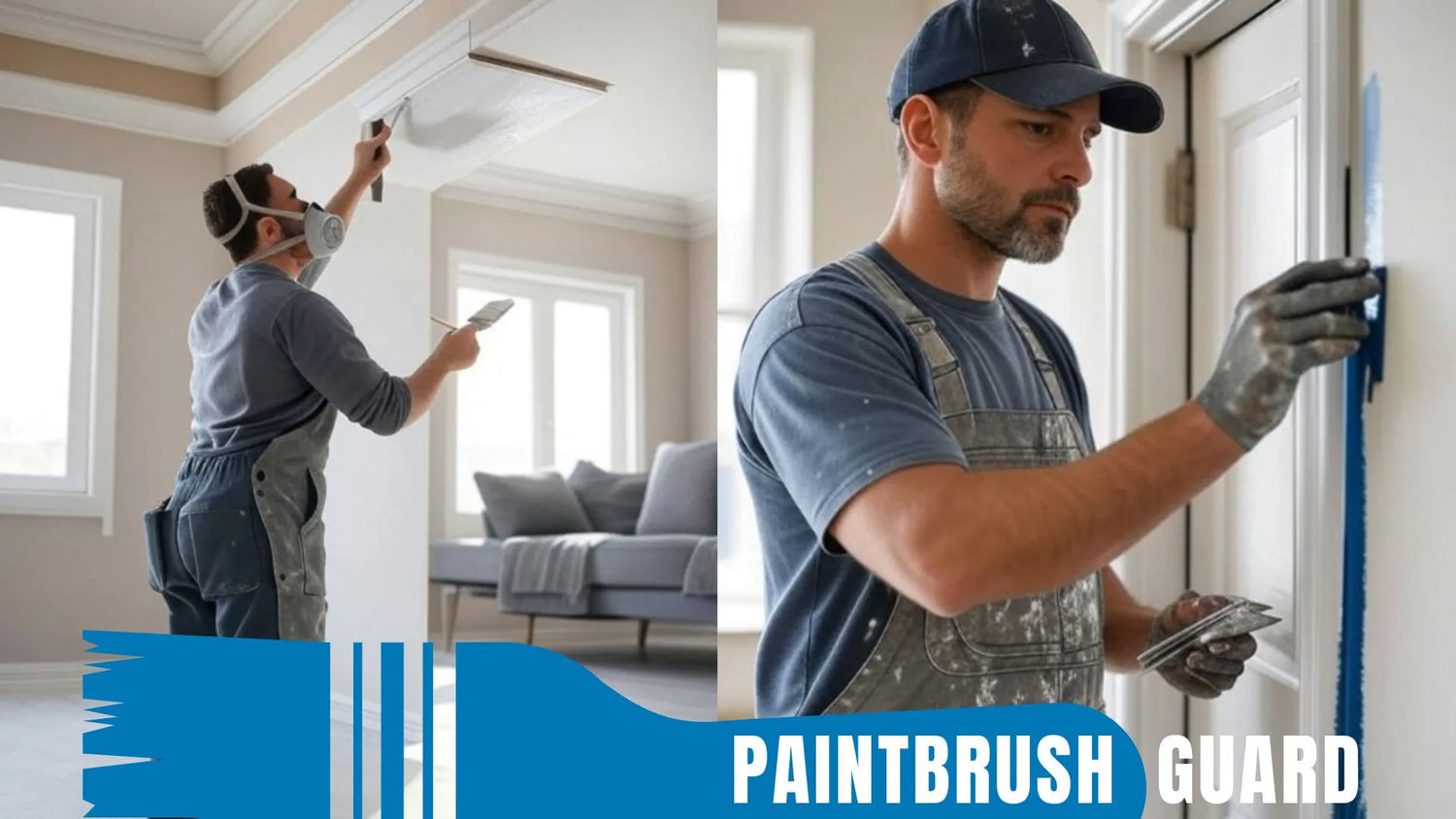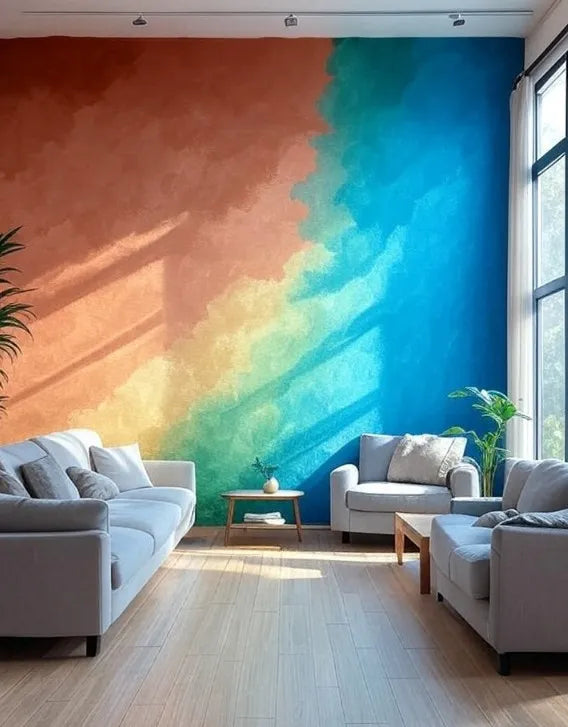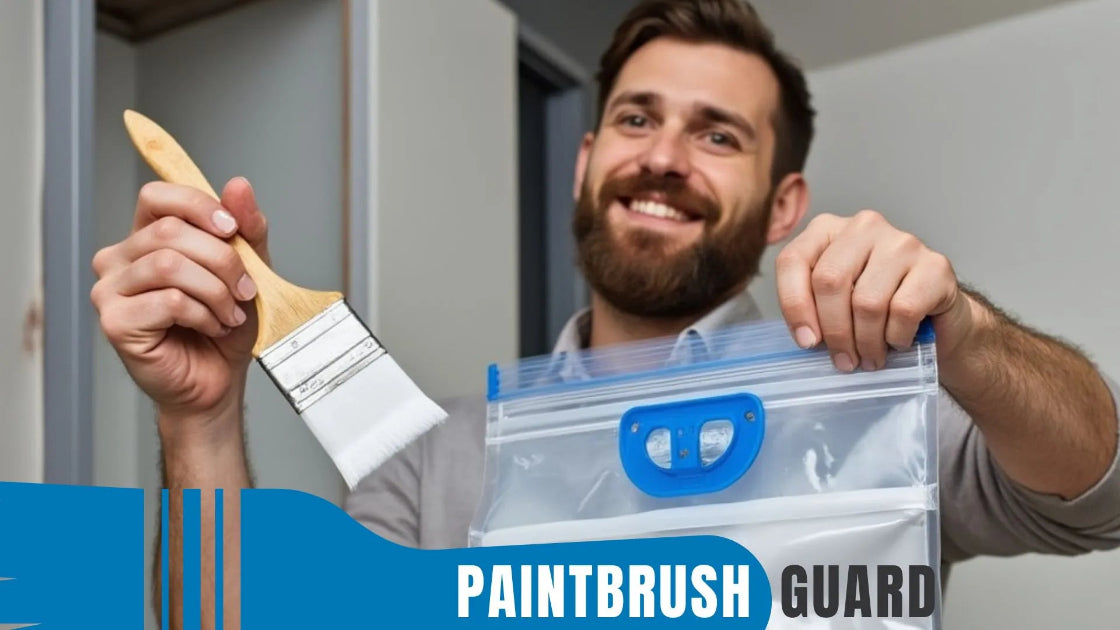
Exterior Brick Painting Tutorial: Tools and Tips for Success
|
Time to read 14 min
|
Time to read 14 min
Exterior brick painting transforms your home’s appearance, modernizes its look and protects brick surfaces from moisture and weathering.
Painting directly on exterior brick is possible but risky without preparation. Uncleaned or damaged brick can cause peeling or moisture issues.
For a durable finish, clean, repair, and prime the surface first. Proper steps ensure painting brick delivers lasting, attractive results without costly problems
This in depth guide covers every aspect from inspection to priming and brick painting, ensuring success for homeowners taking on a large house brick painting project in 2025.
Read our exterior house painting guide: This mega guide gives you clear tips, tools and methods on how to paint all exterior surfaces on your home.
Applying paint straight onto exterior brick without preparation often leads to poor adhesion, peeling or damage.
Brick’s porous nature and exposure to weather require specific steps to ensure paint performs well. Here’s why skipping preparation can cause issues when painting brick exteriors.
Poor Adhesion: Dirt, mildew, or efflorescence on brick prevents paint from sticking, leading to peeling or flaking.
Moisture Trapping: Brick needs breathable paint and proper sealing. Painting directly can trap moisture, causing mold or brick deterioration.
Uneven Finish: Unrepaired cracks or uneven surfaces result in a patchy, unprofessional appearance.
Reduced Durability: Without primer or cleaning, paint fades or chips faster, requiring frequent touch-ups.
These risks highlight the importance of preparing brick before painting.
Brick is a porous and durable material, but it requires careful preparation for exterior brick painting to ensure paint adheres properly and withstands the elements.
Without proper prep, paint can trap moisture, leading to damage or premature failure.
Effective preparation creates a stable, clean surface, enhancing the longevity and aesthetic of your exterior brick painting project while protecting your home’s exterior.
With no cleanup required after a painting session, you can take a short break mid-project or wrap up your painting for the day, your brush stays ready without the need to clean.
Consideration |
Why It Matters |
Surface Cleanliness |
Removes dirt and mildew for better adhesion |
Brick Condition |
Repairs prevent uneven or peeling paint |
Primer Application |
Enhances paint adhesion and longevity |
Breathable Paint Choice |
Prevents moisture buildup and damage |
This table outlines why preparation is critical for painting brick.
Before starting exterior brick painting, inspect the brick surface thoroughly to identify issues.
Check for cracks, spalling (flaking brick), or loose mortar joints, which indicate structural concerns.
Look for efflorescence (white, powdery deposits), signaling moisture issues. Examine for mildew, algae, or old paint that’s peeling or chalking.
For homes built before 1978, test for lead paint with a certified kit, as it requires special handling.
Is painting exterior brick a good idea? Explore pros like enhanced curb appeal, cons like maintenance, and key tips for a lasting finish.
A detailed inspection ensures effective exterior brick painting by addressing problems early.
If lead paint is present, follow EPA guidelines, using wet sanding and HEPA vacuums to minimize dust. Hiring a lead-safe certified contractor may be necessary for safe exterior brick painting.
Persistent efflorescence or dampness suggests underlying water infiltration. Address drainage or sealing issues before proceeding with exterior brick painting to prevent paint failure.
Clean brick is crucial for exterior brick painting to ensure paint adhesion. Dirt, mildew, or efflorescence can cause peeling or uneven finishes.
Use a pressure washer at a medium setting with a 25-degree nozzle to remove dirt, algae, and loose debris, keeping the wand at a 45-degree angle to avoid damaging mortar.
For mildew, apply a solution of one part bleach to three parts water, scrub with a stiff brush, and rinse thoroughly.
For efflorescence, use a masonry cleaner or vinegar solution. Allow the brick to dry fully, typically 48-72 hours, depending on weather. Thorough cleaning is essential for a flawless exterior brick painting result.
If the brick has old paint, use a chemical stripper or wire brush to remove loose or flaking layers, ensuring a clean surface for exterior brick painting.
For grease or oil stains, apply a TSP (trisodium phosphate) solution, scrub, and rinse well to eliminate residue, preparing the brick for exterior brick painting.
Fixing damage is vital for exterior brick painting to achieve a uniform look and prevent further deterioration. Fill small cracks with acrylic masonry caulk, smoothing with a putty knife.
For larger cracks or spalling, patch with a mortar mix matched to the existing mortar color and texture.
Replace severely damaged bricks if necessary. Repoint loose or crumbling mortar joints with fresh mortar, ensuring a flush finish.
Allow repairs to cure, typically 7-14 days for mortar, before proceeding. These repairs create a stable base, enhancing exterior brick painting durability.
Remove loose mortar with a chisel, then apply new mortar with a pointing trowel, matching the joint style for a seamless exterior brick painting prep.
For spalling bricks, remove loose material and patch with a masonry repair compound, ensuring a smooth surface for exterior brick painting.
Tailor your paint and sealer choices to your region’s weather to maximize durability. In humid or rainy areas, prioritize breathable paints and sealers with mildew inhibitors to prevent moisture-related damage.
In dry, sunny regions, select paints with enhanced UV protection to resist fading and cracking.
For coastal areas, consider products resistant to salt corrosion. Check weather forecasts to avoid painting during wet or extreme conditions.
Research local trends to choose colors that boost curb appeal and marketability, and verify with your homeowners’ association (if applicable) to ensure painting brick is permitted and complies with regulations.
Weather significantly impacts exterior brick painting quality . Paint applied in extreme heat, cold, or humidity may crack or dry unevenly.
Aim for temperatures between 50°F and 85°F with low humidity, ideally in spring or fall. Avoid rain or high winds, which disrupt drying or carry debris.
Paint early in the day to allow drying before evening dew, and ensure the brick is dry to the touch. Smart timing ensures optimal exterior brick painting results.
Use a weather app to track humidity and temperature. A hygrometer confirms low humidity, ideal for exterior brick painting success.
Protecting adjacent surfaces simplifies cleanup during exterior brick painting. Use painter’s tape to mask off windows, doors, trim, or siding near the brick.
Cover plants, walkways, or patios with canvas drop cloths, which are durable and slip-resistant. Trim back vegetation to prevent paint from sticking to leaves.
Proper protection keeps your exterior brick painting project tidy and efficient.
Apply tape in short sections, pressing firmly with a putty knife for a tight seal. Remove tape before paint dries to ensure crisp lines for exterior brick painting.
Safe access is key for exterior brick painting, especially for multi-story homes or high brick walls. Use a stable ladder for low areas, or scaffolding and extension poles for higher ones.
Wear safety gear like gloves, goggles, and a mask, particularly when pressure washing or handling chemicals. Ensure good lighting to spot imperfections. For large or high brick surfaces, consider professional help for safety.
A secure setup enhances exterior brick painting quality.
Use a respirator for spraying or cleaning and non-slip shoes on wet surfaces, ensuring a safe exterior brick painting process.
With preparation complete, you're ready to paint your exterior brick for a professional, long-lasting finish.
Follow this step-by-step guide to ensure a flawless exterior brick painting process from start to finish.
Priming seals the porous brick surface and ensures paint adhesion, a critical step in exterior brick painting. Use a high quality masonry or latex primer designed for brick, which allows moisture vapor to escape while blocking water penetration.
Choose a breathable primer to avoid trapping moisture, which can damage brick. For previously painted brick, use a bonding primer to improve adhesion for exterior brick painting.
This article explores is it better to spray or roll exterior paint on brick, comparing the two methods to help you decide.
For highly porous or damaged brick, a second primer coat may be needed, ensuring a solid foundation for exterior brick painting.
Use a synthetic brush for edges and corners and a heavy-nap roller (¾-inch or thicker) for larger areas to apply one even coat, covering all surfaces thoroughly. Ensure the primer is alkali-resistant to handle brick’s high pH levels.
Check the product label for drying time, typically 4–24 hours, and verify the surface is dry and non-tacky before proceeding. This step creates a strong foundation for the topcoat, reducing the risk of peeling.
Brick painting can give your home a fresh, modern look, but it comes with several drawbacks that might make you reconsider.
Selecting the appropriate paint is crucial for exterior brick painting durability and aesthetics.
Pro Tip: Check the paint’s label for temperature and humidity recommendations to ensure optimal application during exterior brick painting.
If you have a historic home, explore the seven best paints for exterior brick painting to preserve its charm and ensure long-lasting protection, as detailed in this article.
Having the right tools streamlines the exterior brick painting process and ensures precision.
Proper tools enhance efficiency and safety during the painting process.
Before starting, stir the paint thoroughly with a stir stick to ensure even color and consistency.
If using multiple cans, mix them in a larger bucket to avoid slight color variations.
This step prevents color inconsistencies and confirms the paint’s suitability.
Begin painting with a steady hand for a smooth exterior brick painting finish.
Allow the first coat to dry fully, typically 4-6 hours for masonry paint, though check the manufacturer’s instructions for specifics.
With no cleanup required after a painting session, you can take a short break mid-project or wrap up your painting for the day; your brush stays ready without the need to clean.
With no cleanup required after a painting session, you can take a short break mid-project or wrap up your painting for the day, your brush stays ready without the need to clean.
Once the first coat is dry, inspect the brick for any missed spots, drips, or uneven areas. Lightly sand any imperfections with 220-grit sandpaper to smooth the surface.
Wipe away dust with a damp cloth to prepare for the second coat.
A thorough inspection enhances the final finish quality.
A second coat enhances durability and provides a rich, even color for your exterior brick painting project.
This step completes the painting process with a professional result.
Once the paint is dry, carefully remove painter’s tape at a 45-degree angle to avoid peeling fresh paint.
Proper cleanup maintains the brick’s appearance and preserves tools.
To extend the life of your exterior brick painting, perform regular maintenance.
Consistent maintenance ensures long-term durability and beauty.
Learn 8 maintenance tips for exterior brick painting durability. Discover how cleaning, inspections, and touch ups ensure your painted brick lasts for years.
If you’re hesitant about painting brick, consider these alternatives for a refreshed look without the permanence of paint:
Whitewashing: Apply a diluted paint mixture for a soft, natural look that’s less permanent and allows brick texture to show.
Limewashing: Use a lime-based solution that bonds with brick, offering breathability and easier removal than paint.
Staining: Brick stains penetrate the surface, changing color while preserving texture and breathability.
These options may suit you if painting directly feels too risky.
Painting brick can impact home value, depending on your local market. Well-executed paint jobs with neutral colors like white or gray often boost curb appeal and attract buyers.
However, skipping preparation may lead to peeling or damage, deterring buyers. In markets valuing natural brick, painting might reduce appeal.
Painting straight onto exterior brick is possible but not advisable due to risks like peeling, moisture damage, and reduced durability.
This article has outlined why preparation, cleaning, repairing, and priming is essential for a lasting finish.
By following these steps or exploring alternatives, you can achieve a beautiful, durable result for your brick exterior.
Preparation is critical for exterior brick painting because brick’s porous nature and exposure to weather can lead to poor adhesion, peeling, or moisture damage if not properly prepped. Thorough inspection, cleaning, repairing, and priming remove dirt, efflorescence, and mildew, ensuring paint bonds well, prevents moisture buildup, and delivers a durable, professional finish.
Inspect for cracks, spalling, loose mortar, efflorescence, mildew, or peeling paint, and test for lead paint in homes built before 1978. Clean with a pressure washer (medium setting, 25-degree nozzle) to remove dirt and debris, use a bleach solution (1:3 with water) for mildew, or a masonry cleaner/vinegar for efflorescence. Rinse thoroughly and let dry for 48–72 hours to ensure a clean surface for exterior brick painting.
Fill small cracks with acrylic masonry caulk and larger cracks or spalling with a matching mortar mix. Replace severely damaged bricks and repoint loose mortar joints with fresh mortar, allowing 7–14 days to cure. For efflorescence or moisture issues, address drainage problems. These repairs create a stable, uniform surface, enhancing exterior brick painting durability.
Use breathable masonry or elastomeric paint formulated for brick to allow moisture escape and prevent mold or damage. Choose paints with UV resistance and mildew inhibitors, in satin or semi-gloss finishes for durability. Apply a high-quality, alkali-resistant masonry or latex primer (or bonding primer for previously painted brick) with a heavy-nap roller or synthetic brush, ensuring a solid base for exterior brick painting.
Apply two thin, even coats of paint in mild weather (50–85°F, low humidity, no rain/wind) using a heavy-nap roller for large areas and a synthetic brush for edges and joints. Work in 3x3-foot sections to maintain a wet edge, allow 4–6 hours drying between coats, and lightly sand imperfections with 220-grit sandpaper. Seal with a breathable masonry sealer for added protection, ensuring a durable, polished exterior brick painting finish.

Learn about eco-friendly painting, tips and tutorials on house interior and exterior surfaces, so you can get started with your project without any surprices during or after your painting.

Learn how interior house paint colors influence mood with expert tips on room preference so you can pick the best colors for a harmonious home environment.
We focus on the most popular shades for each interior colors, so you don't miss no matter what color you pick.

Learn how this innovative tool allows you to store paintbrushes without the need for immediate cleaning, offering significant advantages in time savings, water conservation, reduced chemical pollution, and lower costs for supplies.







